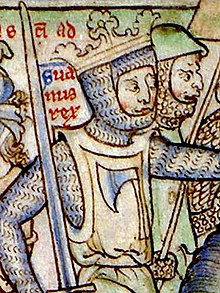Sweyn Forkbeard
| Sweyn Forkbeard | |
|---|---|
 |
|
| King of Denmark | |
| Reign | 986–1014 |
| Predecessor | Harald Bluetooth |
| Successor | Harald II |
| King of Norway | |
| Reign |
|
| Predecessor | |
| Successor | Olaf II |
| King of England | |
| Reign | 1013–1014 |
| Predecessor | Æthelred |
| Successor | Æthelred |
| Born | c. 960 Denmark |
| Died | 3 February 1014 Gainsborough, Lincolnshire |
| Burial | Roskilde Cathedral or St. Trinity in Lund |
| Spouse | Świętosława / Sigrid/ Gunhild (detail) |
| Issue among others... |
|
| House | House of Denmark |
| Father | Harald Bluetooth |
| Mother | Gunhild or Tove |
| Religion | Chalcedonian Christianity |
Sweyn Forkbeard (Old Norse: Sveinn Tjúguskegg; Danish: Svend Tveskæg; 960 – 3 February 1014) was king of Denmark, England, and parts of Norway. His name appears as Swegen in the Anglo-Saxon Chronicle. He was the son of King Harald Bluetooth of Denmark, and the father of Cnut the Great.
In the mid-980s, Sweyn revolted against his father and seized the throne. Harald was driven into exile and died shortly afterwards in November 986 or 987. In 1000, with the allegiance of Trondejarl, Eric of Lade, Sweyn ruled most of Norway. In 1013, shortly before his death, he became the first Danish king of England after a long effort.
Many details about Sweyn's life are contested. Scholars disagree about the various, too often contradictory, accounts of his life given in sources from this era of history, such as the Anglo-Saxon Chronicle, Adam of Bremen's Deeds of the Bishops of Hamburg, and the Heimskringla, a 13th-century work by Icelandic author Snorri Sturluson. Conflicting accounts of Sweyn's later life also appear in the Encomium Emmae Reginae, an 11th-century Latin encomium in honour of his son king Cnut's queen Emma of Normandy, along with Chronicon ex chronicis by Florence of Worcester, another 11th-century author.
...
Wikipedia
